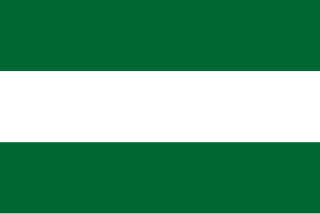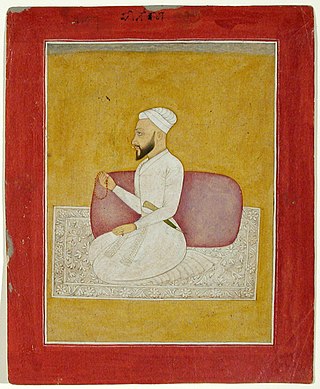Related Research Articles

The Durrani Empire, or the Afghan Empire, also known as the Sadozai Kingdom, was an Afghan empire founded by the Durrani tribe of Pashtuns under Ahmad Shah Durrani in 1747, which spanned parts of Central Asia, the Iranian plateau, and the Indian subcontinent. At its peak, it ruled over present-day Afghanistan, much of Pakistan, parts of northeastern and southeastern Iran, eastern Turkmenistan, and northwestern India. Next to the Ottoman Empire, the Durrani Empire is considered to be among the most significant Islamic empires of the second half of the 18th century.

The Third Battle of Panipat took place on 14 January 1761 between the Maratha Confederacy and the invading army of the Durrani Empire. The battle took place in and around the city of Panipat, approximately 97 kilometres (60 mi) north of Delhi. The Afghans were supported by three key allies in India: Najib ad-Dawlah who persuaded the support of the Rohilla chiefs, elements of the declining Mughal Empire, and most prized the Oudh State under Shuja-ud-Daula. The Maratha army was led by Sadashivrao Bhau, who was third-highest authority of the Maratha Confederacy after the Chhatrapati and the Peshwa. The bulk of the Maratha army was stationed in the Deccan Plateau with the Peshwa.

The Maratha Confederacy, also referred to as the Maratha Empire was an early modern polity in the Indian subcontinent comprising the realms of the Peshwa and four major independent Maratha states who were often subordinate to the former. It was formed in 1674 with the coronation of Shivaji of the House of Bhonsle as the Chhatrapati of the Marathas. The Maratha realm was recognised by Bahadur Shah I, the Mughal emperor, as a tributary state in 1707 after a prolonged rebellion. The Marathas continued to recognise the emperor as their nominal suzerain similar to other contemporary Indian entities.

Balaji Baji Rao, often referred to as Nana Saheb I, was the 8th Peshwa of the Maratha Confederacy. He was appointed as Peshwa in 1740 upon the death of his father, the Peshwa Bajirao I.

Mirza Aziz-ud-Din Muhammad, better known by his regnal name Alamgir II, was the fifteenth Mughal emperor from 1754 to 1759. He was the son of Jahandar Shah.

Raghunathrao Bhat, also known as Ragho Ballal or Raghoba Dada, was the younger son of Peshwa Bajirao I who served as the 11th Peshwa of the Maratha Confederacy for a brief period from 1773 to 1774.

Malhar Rao Holkar was a noble subedar of the Maratha Empire, in present-day India. He was one of the early officers along with Ranoji Scindia to help spread the Maratha rule to northern states and was given the estate of Indore to rule by the Peshwas, during the reign of the Maratha emperor Shahu I. He was founder of the Holkar dynasty that ruled Malwa.

Bala Hissar, also spelt Bala Hisar, is an historic fortress located in Peshawar, Khyber Pakhtunkhwa, Pakistan. First mentioned by 7th-century explorer Xuanzang, the fort was used as a royal residence for the Durrani Empire since 1747, when the Afghan king, Ahmad Shah Durrani, conquered Peshawar. The Marathas briefly occupied it after capturing Peshawar in 1758 but it was soon retaken by the Afghans. The Sikhs destroyed and reconstructed the fort after capturing Peshawar in March 1823. In 1849, the British East India Company reconstructed the fort's outer walls.

The Durrani dynasty was founded in 1747 by Ahmad Shah Durrani at Kandahar, Afghanistan. He united the different Pashtun tribes and created the Durrani Empire. which at its peak included the modern-day Afghanistan, Pakistan, as well as some parts of northeastern Iran, eastern Turkmenistan, and northwestern India including the Kashmir Valley.

Sadashivrao Bhau Bhatt was son of Chimaji Appa and Rakhmabai and the nephew of Baji Rao I. He was a finance minister during the reign of Maratha emperor Rajaram II. He led the Maratha army at the Third Battle of Panipat.

Yashwant Rao Holkar (1776–1811) also known as Jaswantrao Holkar belonging to the Holkar dynasty of the Maratha Confederacy was the Maharaja of the Indore. He was a gifted military leader and educated in accountancy as well as literate in Persian, Marathi and Urdu.

Feroze Jung III or Nizam Shahabuddin Muhammad Feroz Khan Siddiqi Bayafandi also known by his sobriquet Imad-ul-Mulk, was the grand vizier of the Mughal Empire when it was under Maratha suzerainty, making them the de facto rulers.

The Afghan–Sikh wars spanned from 1748 to 1837 in the Indian subcontinent, and saw multiple phases of fighting between the Durrani Empire and the Sikh Empire, mainly in and around Punjab region. The conflict's origins stemmed from the days of the Dal Khalsa, and continued after the Emirate of Kabul succeeded the Durrani Empire.

Adina Beg Khan was a Punjabi general and administrator who served as the last governor of the Punjab region of the Mughal Empire, including the provinces of Lahore and of Multan. He defeated Afghans after rising to power and was recognised as the Nawab of Punjab by Mughal emperor Alamgir II, who also gave him title of Jang Bahadur.

The Afghan-Maratha War was fought between the Afghan Empire under Ahmad Shah Durrani and the Maratha Empire and the Sikh Confederacy between 1758 and 1761. It took place in north-west India, primarily the region around Delhi and Punjab.

Dattaji Rao Shinde, also known as Dattaji Rao Scindia, was the second son of Ranoji Rao Shinde and Maina Bai, alias Nimba Bai. His elder brother was Jayappaji Rao Shinde and his younger brother was Jyotiba.

Tukoji Rao Holkar, belonging to the Holkar clan of the Marathas was the feudatory of Indore. Tukoji Holkar was the adopted son of Malhar Rao Holkar, he was the second son of Shrimant Tanuji Holkar, a nephew of Malhar Rao Holkar. Thus he was also the grand-nephew of Malhar Rao Holkar. He married two wives. He had four sons Kashi Rao, Malhar Rao II Holkar, Yashwant Rao, and Vithoji Rao.

Ahmad Shah Durrani, the founder of the Durrani Empire, invaded Indian subcontinent for eight times between 1748 and 1767, following the collapse of Mughal Empire in the mid-18th century. His objectives were met through the raids and deepened the political crisis in India.
The Battle of Taraori in 1759 was a military engagement between the Durrani Afghans and the Marathas in the fields of Taraori, in which the Afghans were victorious.
The Battle of Sikandrabad was a military engagement between the Afghan Durranis and the Marathas near the city of Sikandrabad.
References
- ↑ Alexander Mikaberidze (22 July 2011). Conflict and Conquest in the Islamic World: A Historical Encyclopedia [2 Volumes]. Abc-Clio. p. 43. ISBN 9781598843378.
The Marathas, assisted by Sikhs, defeated the Afghans and captured Attock, Peshwar and Multan in the spring of 1758.
- ↑ Tom Lansford (2017). Afghanistan at War: From the 18th-Century Durrani Dynasty to the 21st Century. ABC-CLIO. p. 150. ISBN 9781598847604.
However, Timur Shah was driven out of Peshawar in 1758 following his defeat by the Maratha Empire.
- ↑ Hari Ram Gupta (1961). Marathas and Panipat. Chandigarh: Panjab University. p. 97.
Other contemporary Persian records mention that "Tukoji and other cavalry officers sent by Rao Malharji Holkar and Rao Jankoji Sindhia arrived at Peshawar."
- 1 2 Mehta, Jaswant Lal (2005). Advanced Study in the History of Modern India 1707-1813. New Dawn Press, Incorporated. p. 256. ISBN 9781932705546. "The province of Multan and northwest frontier were also overrun by Marathas and the forts of Peshawar and Attock were garrisoned by their troops"
- 1 2 3 Barua, Pradeep (2005). The state at war in South Asia. University of Nebraska Press. p. 55. ISBN 9780803213449.
The Marathas attacked soon after and, with some help from the Sikhs, managed to capture Attock, Peshawar, and Multan between April and May 1758.
- ↑ Pletcher, Kenneth (2010). The History of India. Britannica Educational Pub. p. 198. ISBN 9781615301225.
- ↑ Mehta, Jaswant Lal (2005). Advanced Study in the History of Modern India 1707-1813. New Dawn Press, Incorporated. p. 237. ISBN 9781932705546.
Subsequently , Tukoji Holkar , with 10,000 Maratha soldiers , was posted at Peshawar and Narsoji Pandit took charge of the fort of Attock with a contingent of 4,000 troops.
- ↑ War, Culture and Society in Early Modern South Asia, 1740-1849